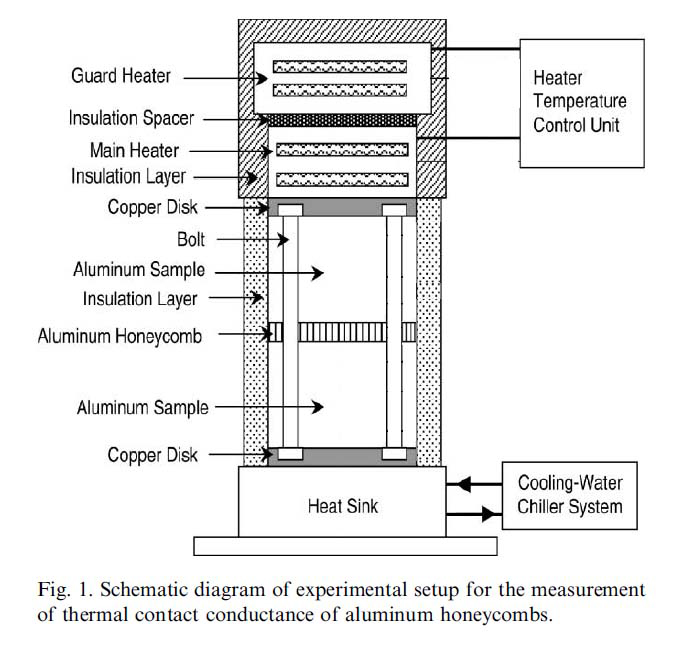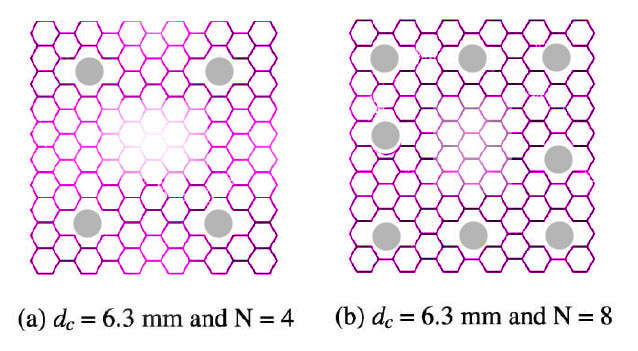Designing Compact Aluminum Honeycomb Heatsinks with Fuji Prescale
Written by Igor Mateski
Keywords: aluminum honeycomb heatsink design, honeycomb tactile thermal resistance, pressure and thermal conductivity, bolt count in heatsink design, bolt torque and thermal conductivity, fuji prescale tactile readout
Summary: Designing compact heatsinks requires using honeycomb structures to reduce weight. Using the Fuji Prescale film engineers can accurately measure tactile pressure which in compact designs directly affects thermal conductivity of bolted aluminum honeycomb heatsinks.
Over the years, various space agencies made significant progress in using dense semiconductors in their items, whether it is a satellite, a weapon or a simple communication device. Dense semiconductors are great to consolidate several components into one. This brings the cost down, and makes manufacturing cheaper. But there is the issue of heat and how to dissipate it without significant heat and power consumption variations.
The need of compact heatsink assemblies
As transistor density grows in semiconductors, the issue of heat also becomes greater. For stationary and for-home devices, heat dissipation is not a big problem because weight and size do not play as big of a role as in military and space-grade devices. This is why space agencies have done significant research in heat dissipation using passive heatsinks. Passive heatsinks are great thermal dissipaters but the down side is their relatively large mass and dimensions in relation to the component they are intended to cool.
Why honeycomb works for heat transfer
There are various engineering teams and research facilities trying to pack a significant heat dissipation capacity into a small and light-weight passive heatsink. Particularly, the research done by C.L. Yeh et al. funded by the National Space Program Office (NSPO) in Taiwan has resulted in a research report that is the first of its kind, combining numerical and experimental thermal dissipation findings that are very significant for the industry.
The experimental measurements conducted by C.L. Yeh resulted in practical conclusions on how to use aluminum honeycomb heat conductors. The team opted for aluminum honeycomb structures because of their light weight, rigidity and exceptional thermal conductivity per mass used.
During their research, the team used honeycombs with various cell size, different number of tightening bolts, as well as bolt diameter and bolt torque. Below is the testing rig schematic:

The testing rig was designed to measure thermal conductivity between the heat source and the heatsink. In order to eliminate any potential thermal dissipation and inconsistency, the rig was designed with aluminum plates that sandwich the honeycomb structure. The rig was thermally insulated.
In summary, based on calculations and real-life measurements, they concluded that small-cell honeycombs (6.7mm side-to-side distance) work better than larger cell honeycomb structures (14.7 diameter cells).
How tactile pressure affects thermal conductivity
During the research and measuring of thermal conductivity the team experimented with the influence of tactile pressure and thermal conductivity. To measure tactile pressure they placed a Fuji Prescale film between the aluminum plate and honeycomb structure.
During the thermal conductivity measurements, researchers tested the effects of high tactile pressure vs. almost no tactile pressure and established that as the thickness of the honeycomb increases, the tactile pressure has smaller influence on thermal conductivity. In other words, to increase conductivity with small honeycombs, the tactile pressure should increase.
The effect of number of bolts was also tested, where researchers established that there is a significant increase of thermal conductivity when using 8 bolts in comparison to using only 4 bolts.
When comparing tactile pressure readouts from the 4 and 8-bolt rigs to the thermal conductivity measurements, engineers confirmed the well-established relationship between tactile pressure and thermal conductivity/resistance. Below is a developed Fuji Prescale film showing the pressure variations between a 4 and 8-bolt design, which directly corresponds to the thermal conductivity of the honeycomb structure.

The screenshot above clearly shows a tactile pressure inconsistency in the central area when 4 bolts are used. This decreased tactile pressure resulted in decreased thermal conductivity. When engineers used 8 bolts, the tactile pressure was almost uniform (see detail to the right), and thermal conductivity increased from 280 to almost 350 W/m2 K.
Thanks to the well established relationship between tactile pressure and thermal conductivity, engineers can easily visualize thermal conductivity of compact (thinner than 14mm) honeycomb heat transfer structures.
